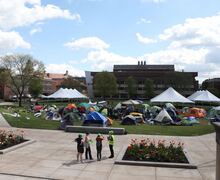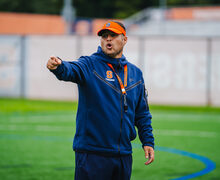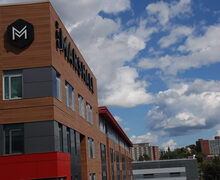State Senators May, Stavisky tour NVRC construction
Richard J Chang | Asst. Copy Editor
State Sens. Toby Ann Stavisky and Rachel May (middle) visited the National Veterans Resource Center on Thursday.
State Sens. Rachel May and Toby Ann Stavisky visited Syracuse University on Thursday to tour the National Veterans Resource Center construction site with military-connected students.
The NVRC will centralize the university’s veteran and military-related services. The $62.5 million, 115,000-square foot facility is expected to open in January 2020. Construction on the building is 90% complete, said Ron Novack, executive director for the Office of Veteran and Military Affairs.
“Syracuse has pushed very hard to be the best place for veterans,” May told The Daily Orange. “This is a symbol of that that is going to be unavoidable, as people who come to campus that are all going to see it.”
The finished center will hold SU’s Institute for Veterans and Military Families, as well as its Army and Air Force ROTC offices. Veteran services at a university should be in a central location rather than spread out across a campus, said Savisky, an SU graduate.
“When I was a student here, veterans were off quite a ways away,” Stavisky said. “Here, next to Marshall Street, they integrated the veterans with the campus, as should be.”
Classroom space for a variety of courses will be available for both ROTC students and the rest of the campus community. Such classrooms are good for “breaking the barrier” between military affiliated students and non-affiliated students, May said. She wants to see the two groups interacting and understanding each other’s experiences.
In recent years, more respect has been given to military veterans, Stavisky said. The NVRC is a welcoming facility that meets the needs of the veteran community, she said.
“We are suddenly realizing that we owe a great deal to veterans,” Stavisky said. “I think what Syracuse is trying to say is ‘thank you for your service.”
Both May and Stavisky spoke about the importance of having a building that is accessible to students and veterans with disabilities. The NVRC includes ramps in the lobby of the building that lead to higher floors, an auditorium and a multi-media center.
“This accessibility is for veterans in particular,” May said. “You have people who come back with all kinds of disabilities — mobility disabilities but also hearing loss and vision loss. And all of that is considered into the design.”
Published on November 1, 2019 at 11:22 am
Contact Richard: [email protected] | @RichardJChang1




